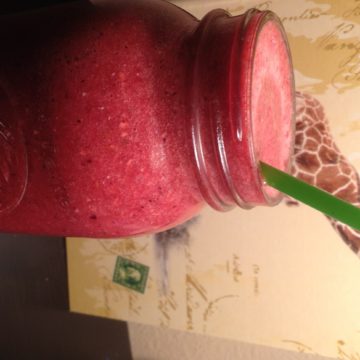Sweden. Every one of my friends who have visited Sweden tell me that this is one enviable country. Picturesque villages; sophisticated cities filled with breathtaking architecture; impeccable social welfare system; a jealousy-inducing sense of style; better thrillers; sanitation and recycling system that’s so efficient that it requires the import of Norway’s garbage; and locals who are extremely civilized and well-mannered. And yes, everyone has told me that they’re all really, really good-looking. But the latest move by this generally forward-thinking country just might put an end to its winning streak: recently, the Swedish government announced that it is changing its official nutritional guidelines to a low-carb, high-fat, high-protein, and low-glycemic diet, most commonly associated with Atkins diet.
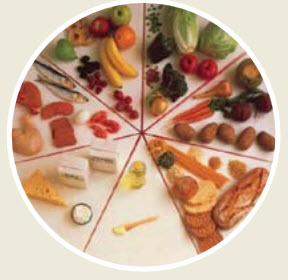 Here is the old Swedish nutritional guideline–Food Circle (Matcirkeln). Interestingly, this circle separates root vegetables from other vegetables, which is not a common practice in many other countries, including the U.S. At any rate, this not-unfamiliar circle will soon be replaced by something that prominently features meats and fats in lieu of carbs like produce and starches. Will Sweden’s move bring about changes in other governments? Or will we finally get to laugh at those good-looking, socially conscious, recycling experts as they find themselves unable to fit into their skinny pants? Only time will tell. But in the meantime, here is a sampler of nutrition guidelines by country.
Here is the old Swedish nutritional guideline–Food Circle (Matcirkeln). Interestingly, this circle separates root vegetables from other vegetables, which is not a common practice in many other countries, including the U.S. At any rate, this not-unfamiliar circle will soon be replaced by something that prominently features meats and fats in lieu of carbs like produce and starches. Will Sweden’s move bring about changes in other governments? Or will we finally get to laugh at those good-looking, socially conscious, recycling experts as they find themselves unable to fit into their skinny pants? Only time will tell. But in the meantime, here is a sampler of nutrition guidelines by country.
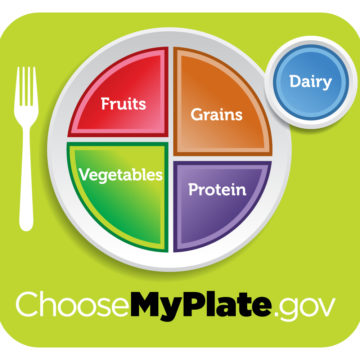 The U.S. uses a graphic, boldly-colored diagram of a plate to show the “ideal” meal, which is sort of fitting since it looks like a TV dinner. I remember that it stirred up a huge controversy when this plate replaced the old food pyramid in 2010, subtly reducing the importance of starches (now called grains) and boosting vegetables. But there is no mention of serving sizes here, or specific pointers on what constitutes which food group. Sugar and fat are missing completely, which might mean that those are not recommended at all, but since Americans consume huge quantities of both every day, it might’ve been worthwhile to show somewhere the maximum quantities and preferred types for each.
The U.S. uses a graphic, boldly-colored diagram of a plate to show the “ideal” meal, which is sort of fitting since it looks like a TV dinner. I remember that it stirred up a huge controversy when this plate replaced the old food pyramid in 2010, subtly reducing the importance of starches (now called grains) and boosting vegetables. But there is no mention of serving sizes here, or specific pointers on what constitutes which food group. Sugar and fat are missing completely, which might mean that those are not recommended at all, but since Americans consume huge quantities of both every day, it might’ve been worthwhile to show somewhere the maximum quantities and preferred types for each.
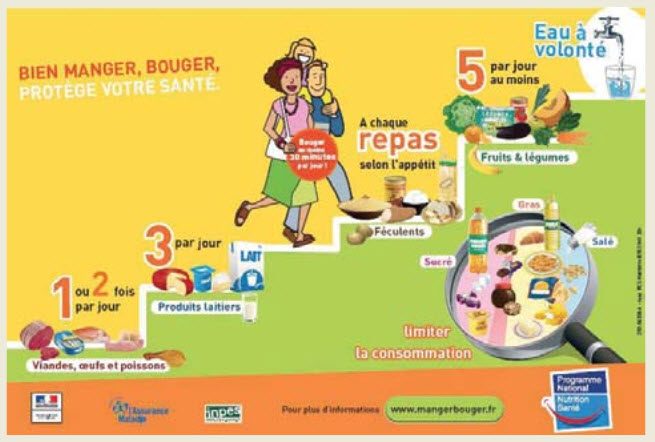 France uses a staircase which is kind of bizarre to my American-trained eye. The idea is that you need to consume more of the designated food groups as you go up the stairs. Once or twice a day, “meat, eggs, poultry”; 3 times a day, dairy products; at each meal, starches; and at least 5 times a day, fruits and veggies. At the top of the stairs is water (notice the subtle sign that tap water is good, in a country where many people drink bottled water around the clock). Inside the magnifying glass are sugar, fat, and salt, to be used sparingly. In terms of detail, it is definitely a step up from the American plate.
France uses a staircase which is kind of bizarre to my American-trained eye. The idea is that you need to consume more of the designated food groups as you go up the stairs. Once or twice a day, “meat, eggs, poultry”; 3 times a day, dairy products; at each meal, starches; and at least 5 times a day, fruits and veggies. At the top of the stairs is water (notice the subtle sign that tap water is good, in a country where many people drink bottled water around the clock). Inside the magnifying glass are sugar, fat, and salt, to be used sparingly. In terms of detail, it is definitely a step up from the American plate.
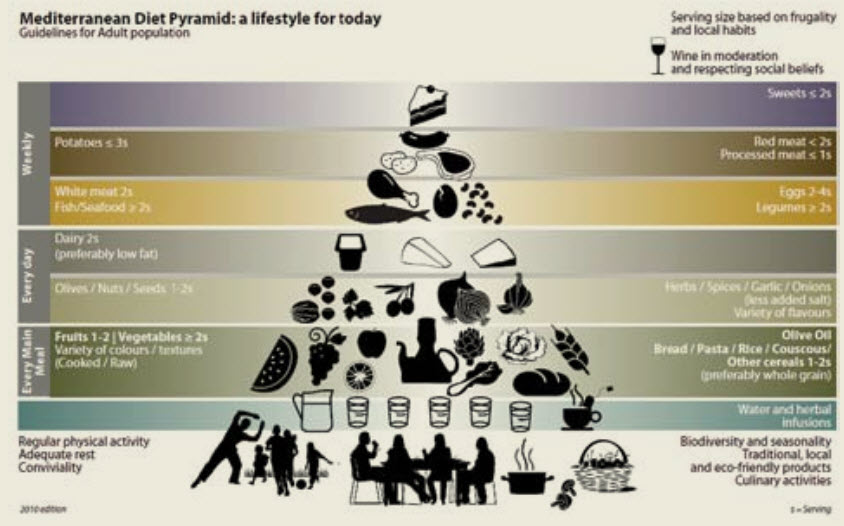 Spain uses the Mediterranean Diet Pyramid, which might be a bit lacking in graphic design but otherwise superior to both the American and French guidelines in terms of detail and thoroughness. At the bottom of the pyramid they advise “regular physical activity, adequate rest,” and even, “conviviality”–perhaps the world’s only official nutrition guideline to do so. There’s even encouragement of biodiversity, seasonality, and local and eco-friendly products. Water is again emphasized, followed by fruits and vegetables–but here Spaniards diverge dramatically by putting olive oil front and center, along with starches. The next level is an unprecedented one of olives, nuts, seeds, herbs, spices, garlic, and onions. This is followed by dairy, fish and legumes, meat, and finally sweets. Wine serving size should accommodate “frugality and local habits…respecting social beliefs”–so basically, when in Rome…
Spain uses the Mediterranean Diet Pyramid, which might be a bit lacking in graphic design but otherwise superior to both the American and French guidelines in terms of detail and thoroughness. At the bottom of the pyramid they advise “regular physical activity, adequate rest,” and even, “conviviality”–perhaps the world’s only official nutrition guideline to do so. There’s even encouragement of biodiversity, seasonality, and local and eco-friendly products. Water is again emphasized, followed by fruits and vegetables–but here Spaniards diverge dramatically by putting olive oil front and center, along with starches. The next level is an unprecedented one of olives, nuts, seeds, herbs, spices, garlic, and onions. This is followed by dairy, fish and legumes, meat, and finally sweets. Wine serving size should accommodate “frugality and local habits…respecting social beliefs”–so basically, when in Rome…
 Korea has a more creative guideline called “Nutritional Formation Bicycle.” The first wheel is a cool glass of water; the back wheel is dominated by starches (bowls of rice, bread, root vegetables). About 20% of the wheel is devoted to meat, eggs, fish (including a squid), and legumes, and what looks like extra firm tofu (hooray! finally). Another 20% goes to veggies, about 15% to fruits, and 15% to dairy, which disturbingly even includes an ice cream cone. A sliver is given to fats, “mayonnaise,” and sugar. Overall, the high percentage given to starches and meats at the expense of produce recalls the old-fashioned American food pyramid.
Korea has a more creative guideline called “Nutritional Formation Bicycle.” The first wheel is a cool glass of water; the back wheel is dominated by starches (bowls of rice, bread, root vegetables). About 20% of the wheel is devoted to meat, eggs, fish (including a squid), and legumes, and what looks like extra firm tofu (hooray! finally). Another 20% goes to veggies, about 15% to fruits, and 15% to dairy, which disturbingly even includes an ice cream cone. A sliver is given to fats, “mayonnaise,” and sugar. Overall, the high percentage given to starches and meats at the expense of produce recalls the old-fashioned American food pyramid.
Japan boasts another creative graphic called “Japanese Food Guide Spinning Top.” Like Korea–and in contrast to the Western countries–this high-carb model prioritizes grains and starches, followed by vegetables, fish and meat, and finally, dairy and fruit.
Now, as a vegan, I can’t say I fully support any of these guidelines, though I do think Spain’s is probably the most sensible. If Peaceful Dumpling were a country, here’s what our official guideline might look like:
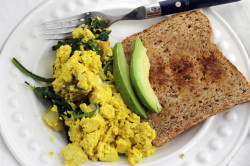
Breakfast: Substantial serving of plant-based protein combined with whole grain starch, veggies, and healthy fats, like this Saturday Morning Tofu Scramble

Lunch: light but satisfying dish that puts vegetables, legumes, seeds, and nuts as the focus, like Vanessa Rae’s Kale and Quinoa Salad
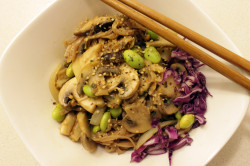
Dinner: Balanced dish using whole, natural starches, vegetables, and legumes like brown rice noodles with edamame and shiitake
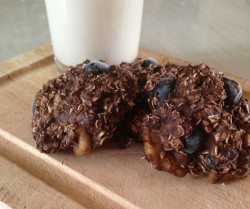
Dessert: Moderate amounts of sweets using naturally sweet ingredients like bananas and berries, or dark chocolate, for added antioxidant boost! For instance, these Raw Berry Banana Chocolate Oat Cookies.
Related: Most Vegan Friendly Countries in the World
Vegan Friendly Countries by Flags
__
Photo: scp-knowledge.eu; choosemyplate.gov; Korean Nutritional Academy; mhlw.go.jp; Peaceful Dumpling; Jessica Ferguson

